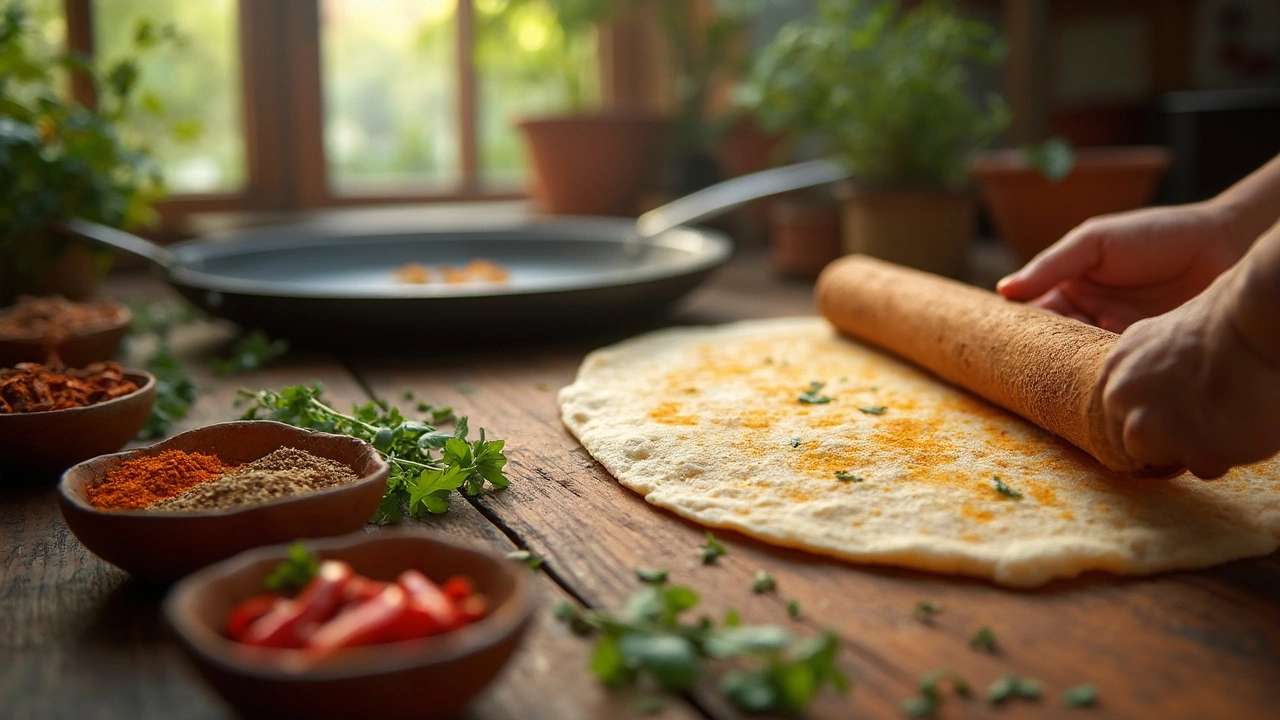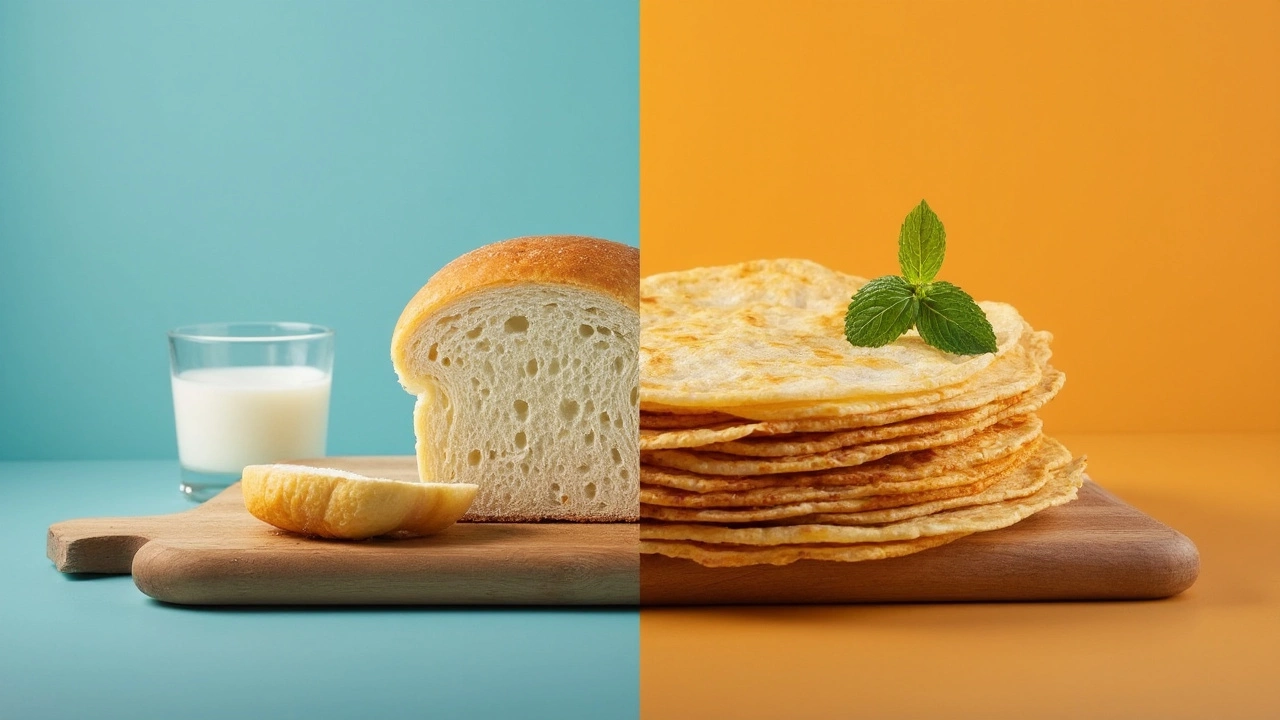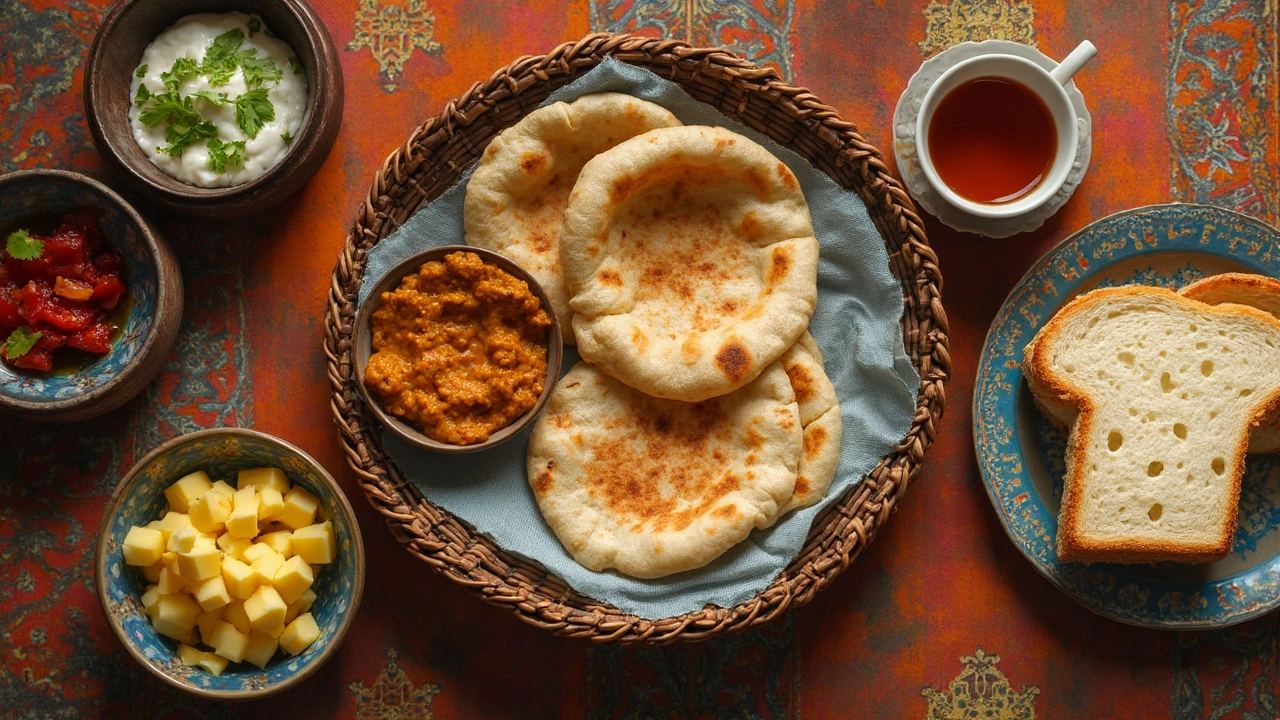Roti vs. White Bread: Choosing the Better Carb
 Feb, 19 2025
Feb, 19 2025
Carbs often get a bad rap, but let's be real—they're essential for energy. Now, if you're staring down at a roti and a slice of white bread, you might be wondering which one's the better carb choice. Spoiler alert: both have their perks, but we're diving into what makes roti a standout choice for many.
First things first—let’s talk calories. How many calories in 1 roti, you ask? Well, you're looking at about 70 to 80 calories. Not bad, right? It gets better if you pair it with sabzi (vegetables). Want to indulge a bit? Adding ghee brings it up to roughly 100 calories, making it richer in flavor.
White bread, on the other hand, often clocks in at around 80 calories per slice, but here's the kicker—roti's got more fiber and nutrients, especially if you’re doing the whole wheat version. Imagine getting the same energy boost, but keeping your digestion happy too.
If you’re eying your carb choices, a step-by-step look at your diet can help. Consider swapping out white bread for roti in meals where possible. It's an easy tweak that can make a significant difference.
- Nutritional Comparison
- Calories in 1 Roti
- Benefits of Choosing Roti
- Practical Tips for a Healthier Diet
- Roti vs. Bread: Making the Choice
Nutritional Comparison
Alright, let's dig into the nitty-gritty of what these carbs really bring to the table. When you're choosing between roti and white bread, understanding their nutritional makeup can make a world of difference. Both have their strengths, but we want you informed to make the best choice for your health.
Calorie and Nutrient Breakdown
Let's start with roti. A single roti generally contains about 70 to 80 calories, a modest amount helping you keep control over your calorie intake. It also packs a punch with fiber, especially if it's made from whole wheat, keeping you fuller for longer—which can be great for managing hunger and aiding digestion.
Here's a simple comparison using a table, just to lay it out clearly:
| Nutrient | Roti (1 piece) | White Bread (1 slice) |
|---|---|---|
| Calories | 70-80 | 80 |
| Fiber (g) | 2.5 | 0.5 |
| Protein (g) | 3 | 2 |
As you can see, roti has an edge in the fiber department. More fiber means it's not just a comforting carb, but also one that's playing the long game with your health. Plus, the protein content adds a nice little boost, helping your muscles and tissues do their thing.
Solving the Carb Conundrum
So, what's the problem here? Well, white bread might be super handy and a childhood comfort food, but it's often low in essential nutrients and doesn't keep that hunger at bay as effectively.
Here's your game plan:
- Swap out white bread for whole wheat roti in more meals. It's versatile—pair it with whatever floats your boat, from curries to soups.
- Keep an eye on portion size, even when switching to healthier options, to maintain balance.
- Want added flavor while keeping things healthy? Add a bit of ghee to your roti, but don’t go overboard. A touch gives you extra taste without sidestepping your goals.
With these steps, you can enjoy your carbs without the guilt and reap some health benefits along the way. Affordable, tasty, and nutritious—roti might just be the carb you've been looking for.
Calories in 1 Roti
Alright, let’s break it down: you're curious about the calories in 1 roti. Whether you're counting for weight management or just getting informed, it's good to know that a plain roti typically contains about 70 to 80 calories. The beauty of roti? It's efficient fuel made from whole wheat flour, which means you're getting more bang for your buck than you might with refined foods.
Wondering how calories in 1 roti stack up when you add a bit of ghee? It's a delicious option that elevates the calorie count to around 100 calories per roti. While that might sound like a lot, the added fats can help you stay full longer, quite the trade-off for those looking to keep hunger at bay.
Pairing Roti with Sabzi
If you're enjoying your roti with a side of vegetables, also known as sabzi, you're still in good shape. Calories in 1 roti and sabzi can vary based on the kind of vegetables or oils used. Vegetables make a nutritious, low-calorie addition, keeping your meal balanced.
Why Do These Calories Matter?
Choosing a healthier carb like roti instead of refined white bread is a simple way to improve your daily diet. The fiber content helps digestion, while the calories are in a range that fits well into various diet plans. It's a practical solution to the often-discussed problem of finding good carbs.
Simply swapping bread for roti in some meals can be a step toward better nutrition. Give it a try and feel the difference in energy and satisfaction.

Benefits of Choosing Roti
So, why is roti a better choice than reaching out for that white bread? For starters, roti, especially when made from whole wheat, brings along a host of health benefits that are hard to overlook.
High in Nutrients
Whole wheat roti is packed with dietary fiber, which is great for digestion and helps you feel full longer. This can be a game-changer if you're watching your weight or trying to curb overeating. Fiber aside, roti carries essential vitamins and minerals like B vitamins, iron, and magnesium that are stripped away during the white bread processing.
Lower Glycemic Index
Roti typically has a lower glycemic index compared to white bread. This means it releases sugar into your bloodstream slowly, avoiding those sudden spikes and drops that can leave you feeling drained. It's particularly useful if managing blood sugar is on your to-do list.
Customizable and Versatile
The beauty of roti is how customizable it is. You can switch up the flour type for a different nutrient profile or add ingredients like flaxseeds for an omega boost. Roll it up with different fillings, use it as a base for wraps, or pair it with a bowl of sabzi for a balanced meal. The possibilities are endless.
Allergen-Friendly Options
If gluten is a concern, there’s a wide variety of gluten-free flour alternatives available, such as almond or chickpea flour, letting you enjoy roti without the worry.
| Type | Calories | Fiber (g) | Protein (g) |
|---|---|---|---|
| Whole Wheat Roti | 70 | 2.5 | 3 |
| White Bread Slice | 80 | 0.8 | 2 |
Clearly, roti stands strong in the nutritional and versatility arena. It’s about making a simple swap that doesn’t force you to give up on taste or satisfaction.
Practical Tips for a Healthier Diet
Switching up your carb intake can be a game-changer for your diet. If you’re curious about incorporating more roti into your meals, here’s how you can do it without breaking a sweat.
Step-by-Step Roti Incorporation
- Start with Breakfast: Instead of toast, try a small roti with a side of yogurt or fruit. It’s a satisfying start to your day with the right balance of energy and fiber.
- Mix and Match for Lunch: Swap your lunchtime sandwich with a roti wrap. Fill it with lean proteins like grilled chicken or chickpeas, plus lots of veggies.
- Satisfy at Dinner: Go traditional with a lovely roti and sabzi combo. This keeps calories in 1 roti and sabzi low while still offering complete nutrition.
Enhancing Your Roti Game
Spice things up by trying different types of whole-grain rotis such as bajra or jowar. They can be more nutrient-dense than regular wheat rotis.
Be Mindful of Portions
- While rotis can be healthier, overconsumption can lead to increased calorie intake. Stick to suggested serving sizes.
- A whole meal with roti vs. bread can help reduce overall calories when planned well.
Roti Stats: At a Glance
Here’s a quick look comparing the caloric intake with popular additions:
| Roti Variation | Calories per Piece |
|---|---|
| Plain Roti | 70-80 |
| Roti with Ghee | 100 |
| Roti & Sabzi | 180-200 |
If you're aiming for a healthier choice, roti is a strong contender. Approach your diet with flexibility, because at the end of the day, balance is what keeps things realistic and manageable.

Roti vs. Bread: Making the Choice
Alright, so you're trying to decide whether your next meal should center around roti or white bread. Here's your guide to making an informed choice.
Understanding the Nutritional Edge
Let's be straight: roti comes with a nutritional edge, especially when made from whole wheat. It's got more fiber and essential nutrients like iron and magnesium. This means better digestion and more sustained energy levels.
White bread, however, often gets stripped of its nutrients during processing. It's fluffy and quick, sure, but not really packing the nutritional punch that roti offers.
Practical Considerations
It’s not just about nutrition; we also need to think convenience. White bread is everywhere. It's fast, it's easy, and it's consistent. Sometimes, life gets busy, and grabbing a slice might just be the simplest choice.
But if you're able to plan a bit, making roti doesn’t have to be tough. Here's a quick guide:
- Prep Your Dough: Mix whole wheat flour with water and a pinch of salt. Knead until smooth.
- Roll It Out: Make small balls, then roll them out thin.
- Cook on a Tawa: Heat a pan and cook each side of the roti till you see bubbles.
It's worth the effort, especially if you're looking for a healthier choice.
Deciding Factor: Personal Goals
In the end, it comes down to your goals. If you’re all about maximizing health, then make roti your go-to carb. But if convenience tops the list, white bread can have its place. Mixing both based on your life’s demands is perfectly okay.
Remember, it’s not about being perfect, but about making the smart choice that fits your lifestyle. Whichever you choose, know you’re making steps toward healthier living.